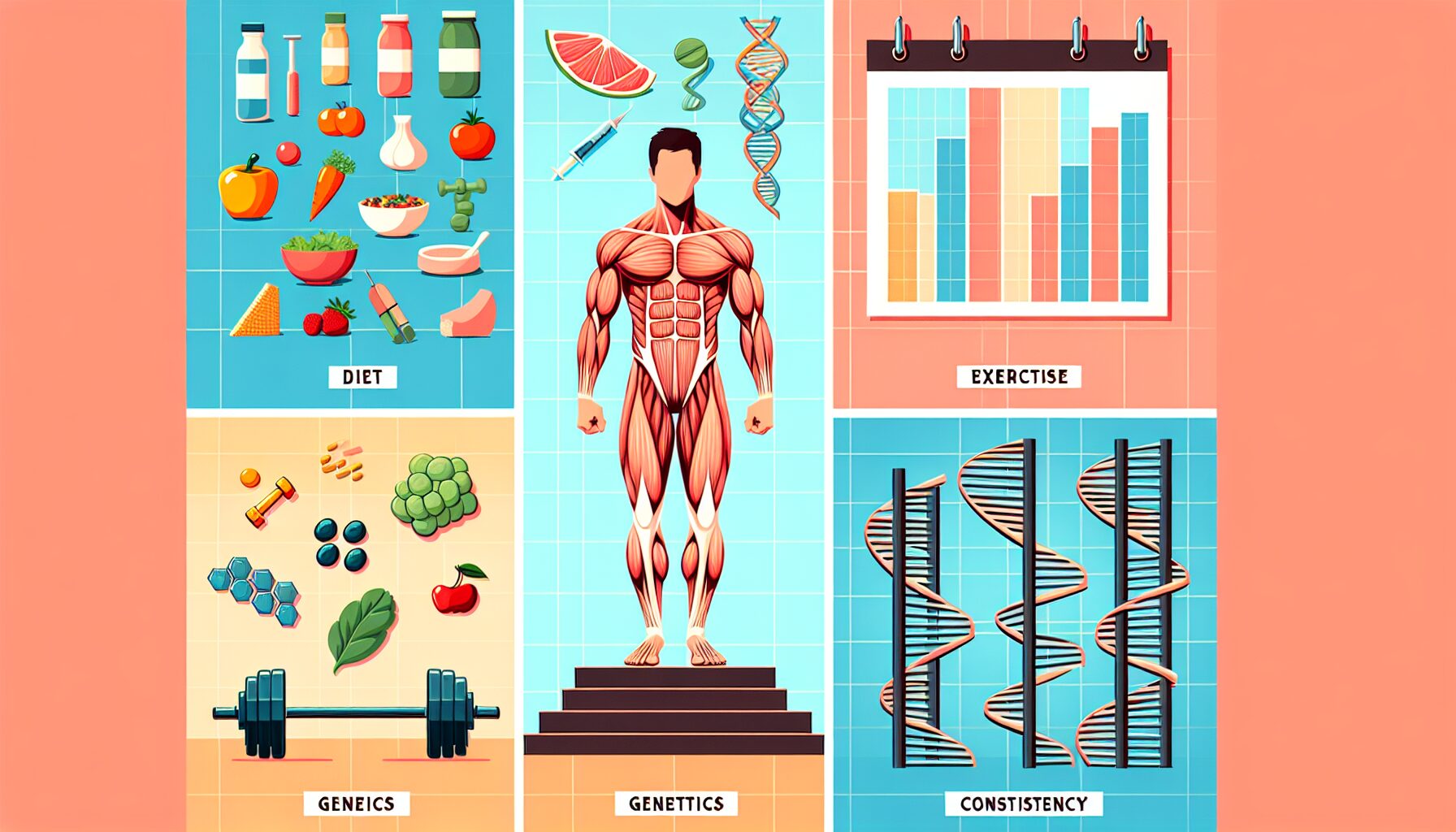You’ve decided it’s time to sculpt the body of your dreams and build some serious muscles. But how long does it actually take to transform into a muscular figure? The road to a sculpted physique might seem daunting, but fear not! In this article, we’ll explore the factors that influence how long it takes to look muscular and uncover some useful tips to help you reach your goals. So buckle up and get ready, because your journey to a muscular physique starts right here!

Factors That Affect the Time It Takes to Look Muscular
Genetics
Genetics play a significant role in how quickly you can achieve a muscular physique. Some people are genetically predisposed to naturally have more muscle mass, while others may find it more challenging to build muscle. While you can’t change your genetics, understanding them can help you set realistic expectations and work towards your goals effectively.
Body Composition
Body composition refers to the ratio of muscle mass to fat mass in your body. If you have a higher percentage of body fat, it may take longer to achieve a muscular appearance since you’ll need to focus on losing fat while building muscle simultaneously. On the other hand, if you have a lower body fat percentage, visible muscle definition may be more apparent.
Diet and Nutrition
Proper nutrition is vital in supporting muscle growth and development. To build muscle, you’ll need to consume a diet that is high in protein to provide the necessary amino acids for muscle repair and growth. Carbohydrates fuel your workouts, and healthy fats support hormone production. It’s essential to ensure you’re consuming enough calories to support muscle growth but also avoiding excessive calorie intake, which can lead to fat gain.
Training Intensity and Frequency
The intensity and frequency of your workouts are crucial factors in achieving a muscular physique. High-intensity training, such as weightlifting, stimulates muscle growth by breaking down muscle fibers and triggering the body’s repair and rebuilding process. Additionally, consistently challenging yourself with progressively heavier weights and increasing the difficulty of your exercises can contribute to muscle growth. The frequency of your training sessions is also important, as consistent training stimulates muscle growth over time.
Rest and Recovery
Rest and recovery are often overlooked but are equally important as training itself when it comes to building muscle. Giving your body adequate time to rest allows for muscle repair and growth. Aim for 7-9 hours of quality sleep each night and incorporate rest days into your training schedule. Additionally, proper recovery techniques such as stretching, foam rolling, and massage can help reduce muscle soreness and prevent injury.
Consistency and Dedication
Consistency and dedication are paramount in achieving a muscular physique. Building muscle takes time and effort, so it’s important to stick to a consistent training program and nutrition plan. Don’t expect to see immediate results; instead, focus on the long-term commitment required to meet your goals. By staying dedicated and maintaining a positive mindset, you’ll be on your way to looking muscular in due time.
Building a Solid Foundation: The Initial Stage
Strength Training
Strength training is the foundation of muscle development. By performing exercises that focus on specific muscle groups, you target those areas to stimulate muscle growth. Compound exercises such as squats, deadlifts, bench press, and shoulder presses are excellent choices for building overall strength and muscle mass.
Resistance Exercise Selection
Selecting the right exercises for your training routine is essential. Choose exercises that target multiple muscle groups and allow for progressive overload. Compound exercises, as mentioned earlier, are ideal for this purpose, as they engage several muscles simultaneously. Additionally, incorporating isolation exercises can help you target specific muscles and further enhance muscle development.
Proper Form and Technique
Maintaining proper form and technique during weightlifting is crucial to prevent injury and maximize muscle growth. Before increasing the weight, ensure you have mastered the correct form for each exercise. Consider working with a qualified personal trainer to learn proper lifting techniques and receive feedback on your form.
Progressive Overload
Progressive overload is the key to continually challenging your muscles and stimulating growth. As you get stronger, you should gradually increase the weight you lift or the level of difficulty of your exercises. This progressive overload forces your muscles to adapt and grow stronger, leading to visible muscle development.
Recovery and Rest
Recovery and rest are just as important during the initial stage as they are in later phases. Aim for at least one rest day per week to allow your muscles to repair and grow. Additionally, incorporating recovery activities such as stretching, foam rolling, and adequate hydration can aid in muscle recovery and prevent overuse injuries.
Gaining Visible Muscle Mass: The Intermediate Phase
Progressive Resistance Training
Progressive resistance training involves systematically increasing the load or resistance over time to continually challenge your muscles. As you progress from the initial stage, gradually increase the weight you lift and the number of sets and repetitions you perform. This progressive overload stimulates further muscle growth and development.
Volume and Intensity
In the intermediate phase, increasing the volume and intensity of your workouts can help accelerate muscle growth. Increasing volume refers to performing more sets and repetitions, while intensity refers to the amount of weight or the difficulty of the exercises. Balancing these factors is crucial to prevent overtraining and ensure muscle growth.
Nutrition and Caloric Intake
As you progress to the intermediate phase, it’s important to reassess your nutrition and caloric intake. To fuel muscle growth, ensure you’re consuming enough protein to support muscle repair and growth. Depending on your specific goals and body composition, you may need to adjust your caloric intake accordingly.
Macronutrient Distribution
In addition to overall caloric intake, the distribution of macronutrients (carbohydrates, protein, and fats) in your diet is essential for muscular development. Aim for a balanced diet that provides an adequate amount of each macronutrient. Protein should make up a significant portion of your diet to support muscle growth and repair.
Supplements
During the intermediate phase, you may consider incorporating supplements into your routine. While supplements are not necessary to build muscle, certain ones can complement a well-rounded diet. Protein powder, creatine, and branched-chain amino acids (BCAAs) are commonly used by individuals looking to enhance muscle growth and recovery.
Reaching an Impressive Muscular Physique: The Advanced Phase
Periodization Training
Periodization training involves dividing your training into specific cycles or phases to optimize muscle growth and prevent plateaus. Typically, these cycles include different training focuses, intensities, and exercises. Periodization allows for progressive adaptation and helps you continue to make gains in muscle development.
Advanced Resistance Techniques
Once you’ve reached the advanced phase, incorporating advanced resistance techniques can further challenge your muscles. Techniques such as drop sets, supersets, and pyramid sets can increase the intensity of your workouts and stimulate further muscle growth. However, it’s important to use these techniques with caution and ensure proper form and technique to avoid injury.
Optimal Nutrition and Supplementation
Optimizing your nutrition becomes even more critical in the advanced phase. Dialing in your caloric intake, macronutrient distribution, and timing can enhance muscle growth and definition. Additionally, considering advanced supplementation strategies, such as specific amino acids or pre-workout supplements, may further support your goals.
Deload Weeks
In the advanced phase, incorporating deload weeks into your training routine is crucial. Deload weeks involve reducing the volume or intensity of your workouts to allow for recovery. This period of decreased training stress allows your muscles to fully recover and avoid overtraining.
Incorporating Cardiovascular Exercise
While resistance training is the primary focus for muscle development, incorporating cardiovascular exercise can have its benefits. Cardiovascular exercise improves cardiovascular health, aids in fat loss, and can enhance overall muscular definition. However, it’s essential to strike a balance between cardiovascular exercise and resistance training to avoid excessive muscle breakdown.

Gender Differences in Muscle Development
Testosterone and Muscle Growth
One significant factor that influences muscle development gender differences is testosterone. Testosterone is a hormone that plays a vital role in muscle growth. Men naturally have higher testosterone levels than women, which gives them a potential advantage when it comes to building muscle mass. However, women can still achieve noticeable and impressive muscle development through targeted training and proper nutrition.
Muscle Fiber Distribution
Muscle fiber distribution also differs between genders. Men generally have a higher proportion of fast-twitch muscle fibers, which are more responsible for strength and power. On the other hand, women tend to have a higher proportion of slow-twitch muscle fibers, which are better suited for endurance activities. Understanding these differences can guide training strategies tailored to each gender.
Hormonal Variations
Besides testosterone, there are other hormonal variations between men and women that can affect muscle development. For example, estrogen and progesterone levels in women can impact muscle repair and recovery. Additionally, hormonal fluctuations during the menstrual cycle can affect performance and recovery. Women may need to adjust their training and nutrition strategies accordingly.
Training Strategies
While both genders can achieve significant muscle development, training strategies may differ. Men may benefit from focusing on heavier weights and lower repetitions to maximize muscle growth. Women, on the other hand, may benefit from incorporating a combination of higher repetitions and lower weights to enhance muscle endurance and definition. Adapting training strategies to individual needs and goals is crucial regardless of gender.
Age and Muscle Development
Muscle Mass Decline with Age
As we age, muscle mass naturally declines. This process, known as sarcopenia, usually begins around the age of 30. The rate at which muscle mass declines can vary depending on genetics, lifestyle factors, and physical activity levels. To counteract muscle loss, resistance training becomes increasingly important as we get older.
Hormonal Changes
Hormonal changes also occur with age and can affect muscle development. For example, older adults may experience a decline in testosterone levels, which can contribute to reduced muscle mass. Additionally, hormonal shifts, such as menopause in women, can impact muscle repair and recovery. Adjusting training and nutrition strategies to account for age-related hormonal changes is crucial for maintaining and building muscle.
Resistance Training for Older Adults
Resistance training is highly beneficial for older adults looking to preserve and build muscle mass. Engaging in regular strength training exercises can help counteract the natural decline in muscle mass and maintain overall strength and functionality. It’s important to work with a qualified trainer who can design a safe and effective training program tailored to your individual needs and abilities.
Recovery and Injury Prevention
As we age, recovery and injury prevention become even more critical. Adequate rest, proper nutrition, and recovery techniques can help prevent overuse injuries and optimize muscle repair. Incorporating activities such as yoga or Pilates can also improve flexibility and joint mobility, reducing the risk of age-related injuries.

Common Pitfalls in Achieving Muscularity
Impatience
One common pitfall when it comes to achieving muscularity is impatience. Building muscle takes time and consistent effort. It’s essential to set realistic expectations and understand that noticeable changes won’t happen overnight. Embrace the journey and focus on the long-term commitment required to achieve your desired muscular physique.
Inconsistency in Training
Consistency is key when it comes to building muscle. Skipping workouts or not sticking to a regular training schedule can hinder progress. Make a commitment to prioritize your training and establish a routine that you can stick to. Consistency is what will ultimately yield results and help you achieve your goals.
Inadequate Nutrition and Hydration
Proper nutrition and hydration are fundamental to muscle development. If you’re not fueling your body with the right nutrients, you may not see the muscle growth you desire. Ensure you’re consuming enough protein, carbohydrates, and healthy fats to support muscle repair and growth. Hydration is also crucial for optimal performance and recovery.
Overtraining
While it’s important to challenge yourself during workouts, overtraining can impede progress. Overtraining occurs when you don’t allow your body enough time to recover between workouts, leading to fatigue and decreased performance. Listen to your body, and if you’re experiencing excessive fatigue, prolonged muscle soreness, or decreased strength, it may be time to incorporate additional rest days or reduce training intensity.
Lack of Rest and Recovery
Rest and recovery are essential components of any muscle-building program. Your muscles need time to repair and grow after intense workouts. Incorporate rest days into your training schedule and prioritize sleep to optimize muscle recovery. Additionally, incorporating recovery techniques such as stretching, foam rolling, and massage can aid in muscle repair and prevent injury.
Tips for Accelerating Muscle Growth
Optimize Training Routine
To accelerate muscle growth, it’s important to continually challenge yourself and optimize your training routine. Consider varying your exercises, increasing the intensity, and incorporating advanced techniques. Seek guidance from a qualified trainer to ensure you’re challenging your muscles effectively and using proper form and technique.
Proper Nutrition and Hydration
Optimizing your nutrition and hydration is essential for accelerating muscle growth. Ensure you’re consuming enough protein, carbohydrates, and healthy fats to support muscle repair and growth. Hydrate adequately before, during, and after workouts to maintain optimal performance and recovery.
Adequate Rest and Recovery
Don’t underestimate the power of rest and recovery in promoting muscle growth. Make sure you’re getting enough quality sleep each night and incorporate rest days into your training routine. Allow your muscles sufficient time to repair and grow to maximize your gains.
Manage Stress Levels
Managing stress is critical for overall health and muscle development. High levels of stress can lead to hormone imbalances and hinder muscle growth. Incorporate stress management techniques such as meditation, deep breathing exercises, or engaging in activities you enjoy to help reduce stress levels and support muscle development.
Track Progress
Tracking your progress can help you stay motivated and make necessary adjustments to your training and nutrition plans. Keep a record of your workouts, measurements, and photos to monitor your muscle growth. Celebrate the small victories along the way, as progress may not always be visible in the mirror.

Setting Realistic Expectations
Individual Differences
It’s important to recognize that everyone’s journey towards a muscular physique is unique. Factors such as genetics, body composition, and lifestyle will influence the time it takes to achieve your goals. Avoid comparing yourself to others and focus on your own progress.
Time Commitment
Building muscle requires time and consistency. Understand that it’s a long-term commitment and that results may not come quickly. Embrace the process, stay dedicated, and remember that every workout and healthy meal is a step towards your goals.
Body Type and Genetics
Genetics play a significant role in muscle development. Some individuals may naturally have a more muscular build, while others may need to work harder to achieve their desired physique. Accepting and working with your unique body type is crucial in setting realistic expectations.
Long-Term Goals
Setting long-term goals is essential when it comes to achieving a muscular physique. Understand that building muscle is a gradual process that requires consistent effort. Set smaller, achievable goals along the way to stay motivated and celebrate each milestone.
Celebrating Small Victories
Don’t forget to celebrate each small victory along the way. Building muscle takes time, so it’s important to acknowledge and appreciate the progress you’ve made. Whether it’s an increase in strength, improvements in body composition, or reaching a personal milestone, celebrate your achievements and use them as motivation to keep pushing forward.
Conclusion
Achieving a muscular physique is a journey that requires dedication, consistency, and a comprehensive approach. Factors such as genetics, body composition, diet, training intensity, and rest all play a role in how long it takes to look muscular. By understanding these factors and implementing the tips and strategies mentioned, you can accelerate muscle growth and work towards your goals effectively. Remember to set realistic expectations, embrace the process, and celebrate every step of your muscularity journey.



